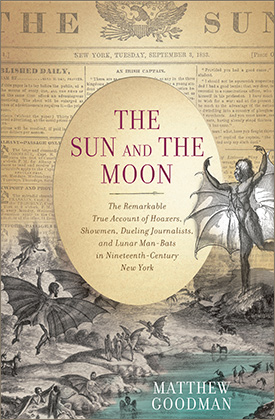THE REMARKABLE TRUE ACCOUNT OF HOAXERS, SHOWMEN, DUELING JOURNALISTS, AND LUNAR MAN-BATS IN NINETEENTH-CENTURY NEW YORK
A Borders Books Original Voices selection
Chosen by The Economist magazine as one of the Best Books of the Year
On Wednesday, August 26, 1835, a fledgling newspaper called the Sun brought to New York the first accounts of remarkable lunar discoveries. A series of six articles purported to reveal the existence of life on the moon — including unicorns, beavers that walked on their hind legs, and, strangest of all, four-foot-tall flying man-bats. In a matter of weeks the series became the most widely circulated newspaper story of the era, and the Sun, a brash working-class upstart less than two years old, had become the most widely read newspaper in the world.
Told in richly novelistic detail, The Sun and the Moon brings the raucous world of 1830s New York City vividly to life — the noise, the excitement, the sense that almost anything was possible. The book overflows with larger-than-life characters, including Richard Adams Locke, the author of the moon series; a fledgling showman named P.T. Barnum, who had just brought his own hoax to New York; and the young writer Edgar Allan Poe, who was convinced that the moon series was a plagiarism of his own work.
An exhilarating narrative history of a divided city on the cusp of greatness and a crew of writers, editors, and charlatans who stumbled onto a new kind of journalism, The Sun and the Moon tells the surprisingly true story of the penny papers that made American into a nation of newspaper readers.
Praise for The Sun and the Moon
“Mr. Goodman has managed not only to give us a ripping good newspaper yarn but also to illuminate life in the nation’s largest city in the early part of the 19th century. He also provides something of a treatise on the birth of modern mass-market newspapering.”
— The Wall Street Journal
“Mr. Goodman’s hucksterish subtitle lives up to its remarkable promise. In this true tale of science fiction the author, a historian, succeeds in recreating mid-19th century Manhattan in vivid fashion. He brings history to life.”
—The New York Times
“A delightful recounting of ‘the most successful hoax in the history of American journalism.’ . . . Goodman consistently entertains with his tale of press manipulation, hucksterism and the seemingly bottomless capacity for people to believe the most outrageous things. Absolutely charming.”
— Kirkus Reviews (starred review)
“A richly detailed and engrossing glimpse of the birth of tabloid journalism in an antebellum New York divided by class, ethnicity and such polarizing issues as slavery, religion and intellectual freedom.”
— Publishers Weekly
“The Sun and the Moon is flat-out fascinating — not only for its brilliant reconstruction of one of the great newspaper hoaxes of the nineteenth century, but also for the Dickensian characters who populate its pages, each more outlandish and outrageous than the other. Hats off to Goodman for one of the most entertaining books about New York City in quite some time.”
— Edwin G. Burrows, Pulitzer Prize-winning co-author of Gotham
“Highly entertaining.”
— Boston Globe
“[A] delightful history. . . . The genius of The Sun and the Moon is that it endeavors to explore, through the lens of 19th-century New York and the prism of the press, why we believe what we believe, particularly when those beliefs go beyond the pale of plausibility.”
— Los Angeles Times
“A compendious, beautifully written account. . . .The Sun and the Moon transcends the merely colorful and becomes a serious, innovative work of intellectual history. Imagine a version of Herbert Asbury’s Gangs of New York where the central currency is not violence but ideas.”
— The Barnes and Noble Review
“A delightful story. . . . Absolutely fascinating.”
— Washington Times
“In The Sun and the Moon, Matthew Goodman has produced an immensely enjoyable account of one of the greatest (unintended) hoaxes of all time.”
— Times Literary Supplement
“Delightful and intelligent. . . . Through the keyhole of the hoax, Goodman provides a panorama of New York life: the poverty and privilege, the religious manias and fierce debates between abolitionists and slave-holders. It’s a rip-roaring story.”
— Scotland on Sunday (UK)

